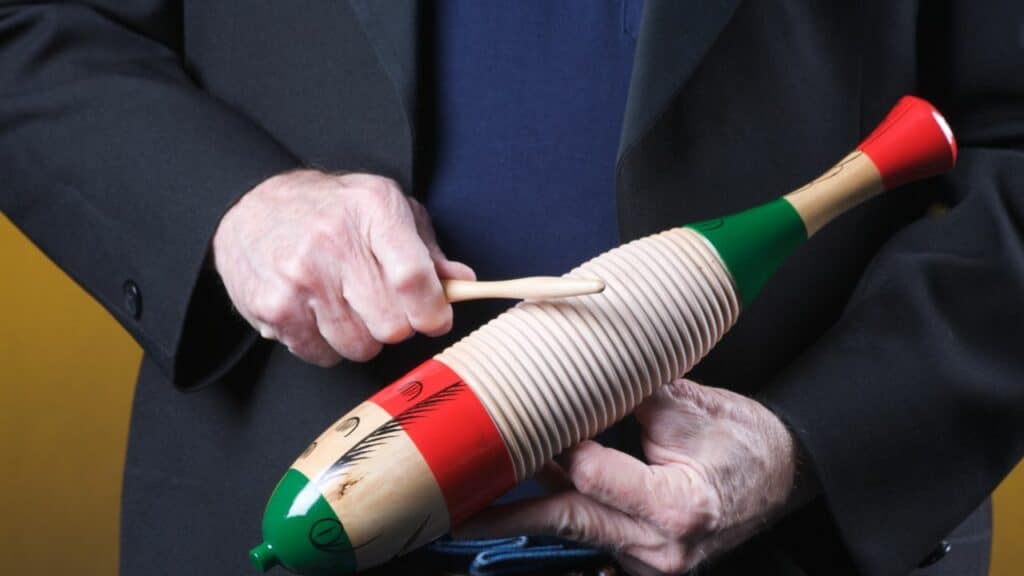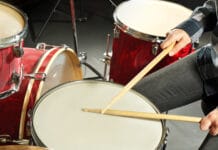Latin Americans use an ensemble of percussion instruments to produce some of the best upbeat rhythms and musical patterns. And the güiro instrument is one of them. In this article, you’ll discover what a guiro is, how it sounds, and more.
What Is a Guiro Instrument?

The guiro is a scrapper idiophone musical instrument common in Cuba, Puerto Rico, Columbia, Mexico, Dominican Republic, and Ecuador. Guiro is a popular percussion instrument in dance music, including salsa.
It is believed that the guiro instrument originated in Puerto Rico. However, some historians argue that guiro came from Africa and was taken to South America. Nevertheless, we can attribute the first-ever recording of guiro back in 1788 by Fray Íñigo Abbad y Lasierra. The Puerto Rican monk presented it as a dance accompaniment along with tambourines and maracas.
Fun Fact: Different Latin countries refer to the scrapped idiophone differently. While Puerto Rico calls it guiro, Brasil name it reco-reco, quijada in Afro-Peruvian, guacharaca in Columbia and the Dominican Republic has guira.
What Material Is the Guiro Made Of?
The traditional way of making guiros is by using the hollowed-out gourd fruit from the higüero plant, a native tree in Puerto Rico. You can also use gourds from other trees found in Latin and Central America.
Generally, the luthier creates a hollow in the gourd and carves parallel notches on its shell. The gourd is then dried and decorated with paintings or carvings.

A special stick or wooden striker called pua scrapes the instrument’s raised ridges. In return, vibration is created, producing a unique resonance sound.
Fun Fact: Different notches sizes and textured surfaces make distinct characteristic sounds of the instrument. It is also not unusual to find a guiro shaped like a frog.
On the other hand, modern guiros are made of fiberglass, wood, bamboo, plastics, or metal. These materials are more durable and have consistent sounds than traditional guiros. Newer versions of guiro don’t rely on scrapping but on fillings or shakings to produce sound.

Instead of the conventional pua, wooden blocks resembling combs with metal tines are gaining traction. Despite new designs and shapes, the traditional gourd remains popular among musicians in Latin America.
What Does a Guiro Instrument Sound Like
When struck by a pua, the guiro produces a raspy or rough sound. While this is true, playing diverse rhythms takes a lot of practice and technique. Since no two gourds are identical, no guiros can be similar. Therefore, precision and perfect timing are vital to produce a constant characteristic sound.
What Are the Parts of the Guiro?

The traditional guiro is only a hollowed gourd with notches on the side. Its design makes it difficult for players to hold and get a firm grip for consistent scrapping. Because of these limitations, the modern guiro has ridges on the surfaces and provision for holes where players can give it a firm grip.
The broad side of the gourd acts as the resonator that enhances the sound of the guiro. Opposite the broad side, the guiro has an opening that allows the sound to move out of the hollow. The notches are prominent, allowing you to strike a huge surface area.
Fun Fact: There are other gourd-based percussion instruments, which include the shekere.
What Kind of Music Is the Guiro Used For?
Guiro is a great percussion instrument for upbeat music genres. In Puerto Rico, guiro is popular in danza, plena and seis music genres. The tool is also widely used in traditional folk dances with jarana, mayapax, cumbia, and merojorana instruments.
Many notable musicians also use it to produce classical orchestras, Bomba, reggae, and plena music.
How to Play Guiro Instrument
The first step in playing the guiro is knowing how to hold the instrument properly. If you have one with two holes, you can hold it in two different ways:
- Option#1: Put your index finger in one hole and the middle finger at the top of the other hole.
- Option#2: Cover the top hole with your thumb and place the body on your palm.
Since you have a firm grip on the instrument and the finger holes, hold the scraper with the opposite hand. Use your index finger around the scraper as holding a drumstick.
Then, move the scraper up and down on the guiro to produce desired musical notes. Quick finger movements create faster tempos like the ones in salsa.
The shape, size, and thickness of the scraper influence the sound produced by the guiro. For instance, you can make a loud, rough sound when you apply strong scratching movement. Also, tapping the body of the guiro can create rich and beautiful rhythmic sounds.
Final Thoughts
Music and dance are integral aspects of every social gathering, from weddings to festivals. But, if you want to create a unique sound, the guiro instrument is your best shot. Just remember that the depth and spacing between the notches or ribbed surface and how hard and fast you scrape it affects its overall sound.
Table of Contents





